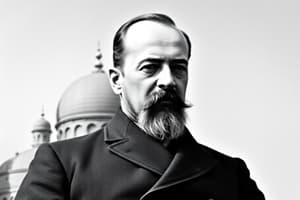Podcast
Questions and Answers
What was one significant change that Mehmed II made to the city of Constantinople during his rule?
What was one significant change that Mehmed II made to the city of Constantinople during his rule?
- He turned the Hagia Sophia into a mosque. (correct)
- He destroyed many Byzantine churches.
- He decreased the population by encouraging emigration.
- He established it as the capital of the Byzantine Empire.
Which group was primarily responsible for the military expansion of the Ottoman Empire?
Which group was primarily responsible for the military expansion of the Ottoman Empire?
- The Byzantine warriors
- The janissaries (correct)
- The Seljuk Turks
- The Greek mercenaries
What marked the establishment of Istanbul as the capital of the Ottoman Empire?
What marked the establishment of Istanbul as the capital of the Ottoman Empire?
- The construction of the Grand Bazaar
- The invasion of the Seljuk Turks
- The reign of Suleyman I
- The fall of Constantinople in 1453 (correct)
What was a major reason for the Ottoman military success during their expansion?
What was a major reason for the Ottoman military success during their expansion?
How did Turkey's population contribute to its cultural identity?
How did Turkey's population contribute to its cultural identity?
What is a significant characteristic of the Ottoman empire in the 1500s and 1600s?
What is a significant characteristic of the Ottoman empire in the 1500s and 1600s?
What is the significance of Anatolia in the context of the Ottoman Empire?
What is the significance of Anatolia in the context of the Ottoman Empire?
What was one of the early historical influences on the area now known as Turkey?
What was one of the early historical influences on the area now known as Turkey?
What role did the Byzantine Empire play in the history of Turkey?
What role did the Byzantine Empire play in the history of Turkey?
Flashcards
Byzantium
Byzantium
Ancient Greek city located on the site of present-day Istanbul, captured by the Romans and renamed Constantinople. It was a key trade location, and after the fall of Rome, became the capital of the Byzantine Empire.
Seljuk Turks
Seljuk Turks
A nomadic people from central Asia, they invaded the area that is now Turkey in the AD 1000s, shaping the region.
Ottomans
Ottomans
Muslim Turkish warriors who conquered land from eastern Europe to North Africa and Arabia, creating the Ottoman Empire.
Janissaries
Janissaries
Signup and view all the flashcards
Mehmed the Conqueror
Mehmed the Conqueror
Signup and view all the flashcards
Grand Bazaar
Grand Bazaar
Signup and view all the flashcards
Blue Mosque
Blue Mosque
Signup and view all the flashcards
Topkapi Palace
Topkapi Palace
Signup and view all the flashcards
Anatolia
Anatolia
Signup and view all the flashcards
Secular
Secular
Signup and view all the flashcards
Study Notes
Turkey
- Turkey's history includes invasions by the Romans, Ottomans, and a 20th-century democracy
- Turkish culture is a mix of modern and traditional
- Modern Turkey is a democratic nation seeking economic opportunities and considering European Union membership
- Historically, Turkey has been more Asian than European, but leaders aim to build economic ties with Europe.
Turkey's History
- 8,000 years ago, the region was home to early farming villages
- Powerful empires, like the Romans, shaped the region
- Byzantium, the ancestor of modern-day Istanbul, was strategically located at the crossroads of Europe and Asia, making it important for trade
- The Byzantine Empire was conquered by the Romans, establishing the city as Constantinople
- Nomadic Seljuk Turks invaded in the 1000s
- The Seljuk Turks were known as the Ottomans in the 1200s
- Ottomans gained lands from Christian Byzantium and expanded into Eastern Europe, North Africa and Arabia
- The key to Ottoman expansion was the Ottoman army, which included soldiers called janissaries who were trained Christians.
- Ottoman expansion used gunpowder weapons, giving them an advantage over other armies.
Mehmed II
- Mehmed II ruled the Ottoman Empire from 1451 to 1481
- He improved the Ottoman capital, Istanbul, by repairing damage, building palaces, mosques, and a bazaar.
- Mehmed II conquered Constantinople in 1453, defeating the Byzantine Empire and making it his capital, which he renamed Istanbul
- He encouraged people to move to the city, growing the population.
- Mehmed II turned the Hagia Sophia, a Byzantine church, into a mosque.
Ottoman Empire (1500s-1600s)
- The Ottoman Empire continued to be powerful, controlling a large territory
- The empire's influence stretched to Northern Africa, Southwestern Asia and Southeastern Europe through the 1800s.
- The empire reached its height under Suleiman I (the Magnificent) from 1520 to 1566, who expanded the kingdom into the Eastern Mediterranean.
Studying That Suits You
Use AI to generate personalized quizzes and flashcards to suit your learning preferences.




